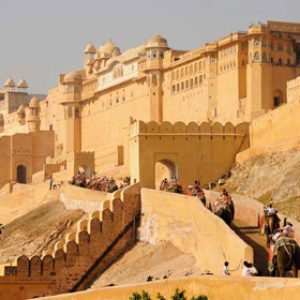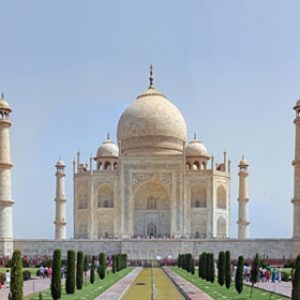The Jantar Mantar was conceived as a quest for discovering the mysteries of the Cosmos. The Jantar Mantar is a corruption of the Sanskrit word yantra mantra meaning instruments and formulae. It was built not only to verify astronomical observations made at Jaipur, but also to stimulate interest in astronomy, which had become enmeshed in theory, superstition and religious jargon. The observatory at Jaipur has the samrat yantra, the jaiprakash yantra, ram yantra and the ‘composite instrument’ includes a sundial and a massive hemisphere on the northern wall.India, in the early decades of the 18th century was a land to turmoil, the Mughal empire was collapsing, its chiefs were busy in internal quarrels, and the Marathas, Portuguese, British, French and Dutch were fighting for the over lordship of India’s trade and political fortunes. In this age arose a brilliant star on India’s political and intellectual horizon – Maharaja Sawai Jai Singh II, Rajput ruler of Amber, founder of Jaipur, a great builder and ruler and an exceptional astronomer.
Commissioned by Emperor Muhammad Shah, to correct the existing astronomical tables and fix planetary positions anew, Sawai Jai Singh-II, accomplished the task in seven years and for this task, built the first stone observatory in Delhi in 1724 and in Jaipur in 1728. Not only did the masonry instruments suit his purposes, they also satisfied his architectural instincts. Apart from being a permanent memorial to his genius, is secured for him a place along with such distinguished observatory builders like Prince Ulugh Beg, Tycho Brahe and John Flam steed.
Instruments at Jantar Mantar
The samrat yantra consists of a massive triangle with a curved structure on both sides. The face of these masonry instruments is lined with marble and has astronomical gradations that may be used to give the local time according to the shadow cast by the triangle and to study the position of the sun and stars by using a metal rod.
The jaiprakash yantra is in the form of two hemispherical bowls representing the celestial spheres and the use of a vertical rod in the centre give different positions of celestial bodies during the day and night, the gradations are etched on the marble lining.
The ram yantra is in the form of a high cylinder surrounded by circular walls and the shadow of the sun on the vertical and horizontal marble gradations via the cylinder, indicates the altitude and the azemuth or declination of celestial bodies.
The composite instrument in Jantar Mantar is heart shaped and has massive triangular central gnomon and circles and the edges of the gnomon and circles are marble-topped and their etchings were used to give the mid-day times of Greenwich (England), Zurich (Switzerland), Notkey (Japan), and Seritchew Islands (Pacific Ocean) as these places and sun observatories too.
On either side of Jantar Mantar is small samrat yantra giving the Jaipur local time and on top is a sun-dial which shows the sun’s position, besides a massive semi-circle on the 5 inclined north wall that shows the entry of the sun into the astrological sign of Cancer.
Sawai Jai Singh’s attempt to introduce a renaissance in astronomy through Jantar Mantar never took off due to chaos in the country, nevertheless in the words of Jawaharlal Nehru, the first prime minister of India, “Jai Singh would have been a remarkable man anywhere and at anytime.”










